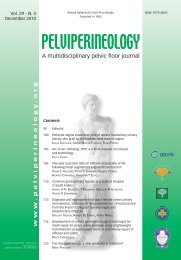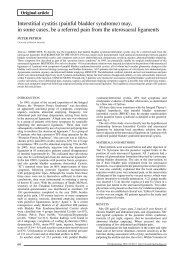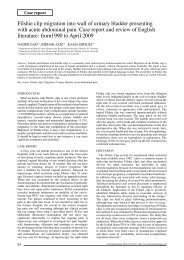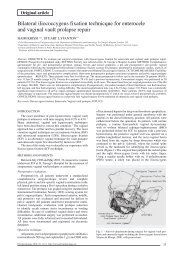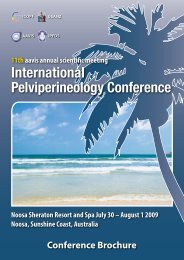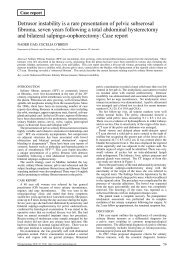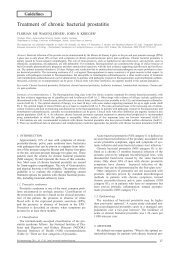intravaginal_posteri.. - Pelviperineology
intravaginal_posteri.. - Pelviperineology
intravaginal_posteri.. - Pelviperineology
You also want an ePaper? Increase the reach of your titles
YUMPU automatically turns print PDFs into web optimized ePapers that Google loves.
Original article<br />
Intravaginal <strong>posteri</strong>or sling procedure (PIVS)<br />
for the treatment of uterine descensus and vaginal vault prolapse:<br />
retrospective analysis of efficacy, safety, complications<br />
and patient satisfaction in 150 cases<br />
KIM M. HAEST (*) - TOM H. HASAART (*) - ILKNUR SANLI (*) - ED T. GONDRIE (**)<br />
MARTIN G. BERGMANS (***)<br />
(*) Dept. of Obstetrics and Gynecology, Catharina Hospital, Eindhoven, The Netherlands<br />
(**) Dept. of Obstetrics and Gynecology, Maasland Hospital, Sittard, The Netherlands<br />
(***) Dept. of Obstetrics and Gynecology, Laurentius Hospital, Roermond, The Netherlands<br />
Abstract: The safety, efficacy and patient satisfaction of the intra vaginal <strong>posteri</strong>or sling procedure (PIVS) for correction of vaginal vault<br />
prolapse or descensus uteri was estimated in 3 Dutch hospitals. A population of 150 patients underwent a PIVS between January 2002 and April<br />
2005 was evaluated retrospectively. Between 4 and 18 months after the operation an inquiry was sent to all to evaluate the results after this<br />
middle-long follow-up period. In 87% (131/150) PIVS was combined with other surgical techniques as vaginal hysterectomy, anterior and/or<br />
<strong>posteri</strong>or vaginal wall repair. No complications occurred during surgery. Complications post operatively were: cystitis 13, fever 1, hematoma<br />
8. After 8 weeks there was no improvement of prolapse complaints in 16 patients (11%). In 19 (13%) a secondary prolapse was found, mainly<br />
cystocele (14 patients). Of the 100 patients with micturition or urinary incontinence problems before the operation, 70 experienced improvement<br />
of their presenting complaints. De novo urgency was found in 12 patients (8%). Tape erosion occurred in 4 patients (2.6%) during the<br />
follow-up period. Response rate of the questionnaire was 65%. The mean score for patient satisfaction was 4.8 (range 0-5) and the mean score<br />
for efficacy 4.6 (range 0-5). PIVS is a safe and effective treatment for vaginal vault prolapse or descensus uteri, with a high score for patient<br />
satisfaction during a medium follow-up.<br />
Key words: Vaginal vault prolapse; Posterior <strong>intravaginal</strong> sling.<br />
INTRODUCTION<br />
The <strong>posteri</strong>or <strong>intravaginal</strong> sling procedure (PIVS) is a<br />
surgical technique for the treatment of vaginal wall prolapse<br />
or descensus uteri. It was described by Petros in<br />
1997 and is considered to be less invasive when compared<br />
to classical surgical procedures. 1 Through two small perianal<br />
incisions a tunneler (Tyco IVS Tunneler TM Device)<br />
is guided to the ischial spine on both sides, where the<br />
sacrospinous ligament is perforated just medial to the spine<br />
to reach the paravaginal space. A polypropylene tape (8<br />
mm wide multifilament polypropylene tape Tyco Healthcare,<br />
the Netherlands) is pulled through the tunneler. After<br />
removal of the tunneler the tape is fixed to the vaginal<br />
vault or the <strong>posteri</strong>or side of the cervix. Pulling the tape<br />
will now lift the vaginal vault or cervix and create suspension<br />
as an artificial neoligament.<br />
The goal of the present retrospective study is to evaluate<br />
efficacy and safety of PIVS for the treatment of vaginal wall<br />
prolapse or descensus uteri, as well as patient satisfaction.<br />
MATERIAL AND METHODS<br />
Three Dutch hospitals participated in the study: Catharina<br />
Hospital Eindhoven, Laurentius Hospital Roermond and<br />
Maasland Hospital Sittard. All patients who underwent a<br />
PIVS procedure between January 2002 and April 2005 were<br />
studied retrospectively. The following data were collected:<br />
a. History: gynaecological operations, pessary use, pelvic<br />
floor physiotherapy, estrogen use, parity, mode of delivery,<br />
birthweight of the children, chronic obstructive pulmonary<br />
disease.<br />
b. Complaints: prolapse, voiding dysfunction, urinary stressor<br />
urge incontinence, defecation disorders, dyspareunia.<br />
c. Physical examination: age, weight, height. During vaginal<br />
examination the position of the cervix or vaginal vault<br />
and the presence of cystocele, rectocele and enterocele was<br />
graded according to the Baden-Walker halfway classification<br />
system for grading prolapse, with patients straining<br />
maximally in the dorsal lithotomy position: 2<br />
<strong>Pelviperineology</strong> 2007; 26: 101-103 http://www.pelviperineology.org<br />
• Grade 0: normal position for each respective site<br />
• Grade I: descent halfway to the hymen.<br />
• GradeII: descent to the hymen<br />
• Grade III: descent halfway past the hymen<br />
• Grade IV: maximum possible descent<br />
for each respective site.<br />
d. Surgical procedure: duration, blood loss, combination<br />
with other surgical techniques (colporrhaphy anterior or<br />
<strong>posteri</strong>or, hysterectomy, tension free transvaginal tape for<br />
urinary stress incontinence (TVT), use of vaginal pack, urinary<br />
catheter, complications.<br />
e. Hospital stay: length, time of catheter removal, wound<br />
infection, fever (> 38 ºC), cystitis, and hematoma.<br />
f. Outpatient visit after 6 weeks: effect on pre-existing<br />
complaints, new complaints, vaginal assessment according<br />
to the Baden-Walker classification, signs of tape erosion.<br />
Subsequently a questionnaire was sent to all involved<br />
patients 4-18 months after surgery. In this way the effect on<br />
pre-existing complaints was evaluated and the appearance<br />
of new complaints, specifically on sensation of prolapse,<br />
micturition, incontinence, stool and intercourse. They were<br />
asked to judge efficacy and satisfaction from their point of<br />
view by scoring both with a figure of 0-5, in which 0 stands<br />
for no or a negative effect and 5 for an excellent effect.<br />
Those who did not respond were contacted by phone and<br />
invited to participate. For evaluation all data were stored in<br />
the database program Microsoft Access.<br />
RESULTS<br />
A total of 150 patients were included. (Eindhoven 87,<br />
Roermond 44, Sittard 19). Median age was 62 years (range<br />
35-86), median BMI 26 kg/m 2 (range 21-34), and median<br />
parity 2 (range 0-8). They all had vaginal deliveries except<br />
one who had a cesarean section. Birth weights were >3500<br />
grams in 110 cases (55%). Twelve had a history of chronic<br />
obstructive pulmonary disease (8%).<br />
Pre-existing complaints were: prolapse 125 (85%), urinary<br />
incontinence 79 (urge 43, stress 21, mixed 15, together<br />
101
K. M. Heast - T. H. Hasaart - I. Sanli - E. T. Gondrie - M. G. Bergmans<br />
TABLE 1. – Pre-operative assessment of cervical or vaginal vault prolapse, and combinations with anterior and <strong>posteri</strong>or vaginal wall prolapse.<br />
descensus cervix/<br />
rectocele cystocele no significant<br />
cystocele<br />
vaginal apex enterocele recto/enterocele cysto/rectocele<br />
total<br />
C<br />
E<br />
R<br />
V<br />
I<br />
X<br />
grade 1 0 1 2 0 3<br />
grade 2 10 19 11 0 40<br />
grade 3 2 1 3 0 6<br />
grade 4 2 0 0 15 17<br />
vault prolapse grade<br />
3 or 4 39 33 8 4 84<br />
representing 53%), constipation 39 (26%) of whom 5 initiated<br />
or assisted defecation with vaginal digitation and dyspareunia<br />
26 (17%).<br />
Before operation 48 used a pessary, 21 had pelvic floor<br />
physiotherapy and 51 used vaginal estrogens. Eighty four<br />
patients (56%) had a past history of hysterectomy (57 vaginal,<br />
27 abdominal).<br />
The pre-operative findings in physical examination are<br />
summarized in table 1. Of the 66 women who still had<br />
their uterus, 17 had cervical prolapse below the level of the<br />
hymen (26%). Fifteen patients had no significant anterior<br />
or <strong>posteri</strong>or vaginal wall prolapse. All 84 women without<br />
uterus had a vaginal vault prolapse grade 3 or 4. Only four<br />
patients in this group (5%) appeared to have no significant<br />
prolapse of the anterior or <strong>posteri</strong>or wall.<br />
The types of operation performed in the study population<br />
are summarized in table 2. In 19 patients PIVS was not combined<br />
with other surgical procedures. In the majority PIVS<br />
was combined with anterior and/or <strong>posteri</strong>or repair, or vaginal<br />
hysterectomy.<br />
In the case of an isolated PIVS procedure, operation time<br />
was less than 45 minutes. No complications occurred during<br />
surgery. At the end of the operation a urinary catheter was<br />
placed in all cases and a vaginal pack in 144 cases. Vaginal<br />
pack and urinary catheter were removed the following morning.<br />
Median hospital stay was 3 days (range 1-12).<br />
Postoperative complications were: fever 1, cystitis 13, and<br />
hematoma 8 (two required surgical intervention).<br />
Six weeks after operation the effect of the procedure on<br />
TABLE 2. – Operations performed in the study group in combination<br />
with PIVS.<br />
PIVS alone 19<br />
with colporraphy anterior 21<br />
with colporraphy <strong>posteri</strong>or 59<br />
with colporraphy anterior and <strong>posteri</strong>or 36<br />
with vaginal hysterectomy 14<br />
with IVS anterior 1<br />
Total 150<br />
PIVS = <strong>posteri</strong>or <strong>intravaginal</strong> sling.<br />
the presenting symptoms was evaluated. The majority of<br />
women experienced disappearance or significant improvement<br />
of their pre-existing complaints: prolapse sensation (n<br />
= 109/125, 87%), micturition or incontinence problems (n =<br />
70/100, 70%). De novo urgency occurred in 12 cases. Nine<br />
patients improved with conservative therapy. Three underwent<br />
a subsequent anterior repair.<br />
During the follow-up period of 4 months up to 18 months<br />
19 women developed a prolapse recurrence (13%) of which<br />
13 were of the anterior wall, 2 of the <strong>posteri</strong>or wall, 3 of the<br />
vaginal vault and one a combined prolapse. Thirteen needed<br />
additional surgical treatment. In one of them no adequate suspension<br />
was obtained and the operation was deemed a failure.<br />
Tape erosion was found in 4 women (3%). In 2 cases the<br />
tape had to be removed due to local infection. In the other 2<br />
cases cutting of the exposed tape was sufficient to heal the<br />
affected area.<br />
The response to the questionnaire was 65% (98/150). The<br />
effect on pre-existing complaints is summarized in table 3.<br />
A satisfactory effect on prolapse symptoms was found in<br />
93% of patients (77/83). For micturition problems or urinary<br />
incontinence it was 54% (31/57), although 7 patients<br />
(12%) experienced increase of complaints after surgical<br />
treatment. The same pattern was found for dyspareunia.<br />
Defecation problems were significant less postoperatively<br />
in 63% (22/35) and unchanged in 37%.<br />
Six weeks after the operation 12 women reported de novo<br />
urgency. Five of these 12 participated in the questionnaire<br />
study and all of them still had urgency complaints to some<br />
degree. Five women who had no urgency problems six<br />
weeks after operation have developed this complaint subsequently.<br />
All participating women (98) were asked to score satisfaction<br />
and effectiveness of the surgical procedure from 0<br />
to 5. The mean score for satisfaction was 4.8 and for efficacy<br />
4.6.<br />
DISCUSSION<br />
With PIVS a new surgical technique has been introduced<br />
for the treatment of uterine prolapse and vaginal vault prolapse.<br />
It is important to determine the safety and effectiveness<br />
of such a procedure.<br />
TABLE 3. – Influence of surgical treatment on pelvic floor disorders.<br />
Influence of prolapse surgery Pre Op. Post Op.<br />
Complete cure Improved Unchanged Worse<br />
Prolapse sensation 83 0 77 3 3<br />
Micturition problems/incontinence 57 26 5 7 19<br />
Defaecation problems 35 22 6 13 0<br />
Dyspareunia 24 22 6 6 6<br />
102
Intravaginal <strong>posteri</strong>or sling procedure (PIVS) for the treatment of uterine descensus and vaginal vault prolapse<br />
TABLE 4. – Complications of surgical treatment of prolapse using PIVS.<br />
Literature<br />
Cases<br />
Surgical<br />
complications<br />
Fever Hematoma Cystitis Tape erosion<br />
Biertho et al. 5 34 0 – 0 – 1<br />
Everhardt et al. 6 32 0 – – – 8<br />
Farnsworth 3 93 2 0 0 5 1<br />
Haest et al. 150 0 1 8 13 4<br />
Meschia et al. 4 33 0 – – – 1<br />
Petros 1 75 2 0 0 – 4<br />
In our study there were no operative complications. In<br />
table 4 complications are described in the literature of 417<br />
cases of PIVS by 6 authors. The most significant complication<br />
was rectal perforation in 4 cases (1%).<br />
1, 3-6<br />
In our study population, 8 patients developed hematoma<br />
of the vaginal wall after operation. Two of them were treated<br />
surgically.<br />
Postoperative cystitis was found in 8.6% in our study and<br />
in 5.4% in the study of Farnsworth. 3 Wagner et al studied<br />
the incidence of cystitis after abdominal and vaginal hysterectomy<br />
combined with anterior or <strong>posteri</strong>or colporrhaphy. 7<br />
The reported incidence of cystitis as proven by culture was<br />
45%.<br />
We found tape erosion in 4 patients (3%) after a follow-up<br />
of 4-18 months. In the literature the reported incidence is<br />
1% (Farnsworth) to 25% (Everhardt). 3, 6 Biertho described<br />
a tape erosion as early as 2 weeks after operation. 5 Learning<br />
curves (tape placed too superficially), variable follow<br />
up periods (2 months to 4.5 years) and variable degrees of<br />
vaginal wall atrophy, will have contributed to the differences<br />
in incidence of tape erosion. Long term results are still<br />
unknown.<br />
The incidence of prolapse recurrence after classical prolapse<br />
surgery is high. One year after operation Whiteside<br />
et al. found, in 389 patients, 58% recurrences grade 2 and<br />
10% recurrences grade 3. 8 In our population prolapse recurrence<br />
was found in 13%. Petros always combined PIVS with<br />
bridge repair of the <strong>posteri</strong>or vaginal wall. In his series (75<br />
patients) he noted recurrence at 1 year of <strong>posteri</strong>or wall prolapse<br />
2% and anterior wall prolapse 8%. Review at 4.5 years<br />
showed a failure of 5.2% and 16% respectively. 1 Meschia<br />
published a randomized trial in 66 women. He compared<br />
two groups of 33 women, each with vaginal vault prolapse<br />
of grade 3 or more. One group was treated with sacrospinous<br />
fixation of the vaginal vault. The other group had<br />
PIVS. Median follow-up was 18 months. Prolapse recurrence<br />
was found in 12% of the sacrospinous fixation group<br />
and in 12% of the PIVS group (not significant). 4 We conclude<br />
that recurrent prolapse seems to be less when classical<br />
prolapse surgery is combined with PIVS.<br />
Our study showed symptom improvement as follows:<br />
prolapse sensation in 93%, micturition problems or urinary<br />
incontinency in 54%, defecation difficulties in 63% and dyspareunia<br />
in 50%. These results are in concordance with literature.<br />
Petros defined cure as a reduction of 50% or more in complaints.<br />
1 According to this definition he found a cure rate for<br />
prolapse complaints of 91% for PIVS treatment. Farnsworth<br />
used the same definition and found a cure rate of 91% for<br />
prolapse sensation, 79% for urgency, 82% for nocturia and<br />
78% for pain, using PIVS. 3<br />
We found de novo urgency in 12 patients (8%), of whom 5<br />
still had complaints at the end of the follow-up period. This<br />
complication is not evident in other studies of PIVS. In classical<br />
prolapse surgery it is a well recognized complication.<br />
Borstad et al. reported de novo stress incontinence in 22%<br />
(16/73) after vaginal repair. 9 In our study we did not identify<br />
any cases of de novo stress incontinence after surgery.<br />
Six women (4%) reported dyspareunia, which was not<br />
present preoperatively. In all these cases the <strong>intravaginal</strong><br />
sling procedure was combined with classical vaginal repair<br />
of one or more compartments. Other studies on PIVS do not<br />
report data on dyspareunia.<br />
Patient satisfaction according to the questionnaire results<br />
was very high: the effect of the procedure on pre-existing<br />
complaints was rewarded with 4.8 points out of 5 for satisfaction<br />
and 4.6 out of 5 for efficacy.<br />
This retrospective study shows that PIVS is a safe and<br />
effective treatment modality for uterine and vaginal wall<br />
prolapse. Follow-up is needed to assess long term safety.<br />
REFERENCES<br />
1. Petros PE. Vault prolapse II: restoration of dynamic vaginal<br />
supports by infra-coccygeal sacropexy, an axial day-case vaginal<br />
procedure. Int Urogynecol J 2001; 12: 296-303.<br />
2. Baden WF, Walker TA. Physical diagnosis in the evaluation of<br />
vaginal relaxation. Clin Obstet Gynecol 1972; 15: 1055-1069.<br />
3. Farnsworth BN. Posterior <strong>intravaginal</strong> slingplasty (infracoccygeal<br />
sacropexy) for severe posthysterectomy vaginal vault<br />
prolapse - a preliminary report on efficacy and safety. Int Urogynecol<br />
J 2002; 13: 4-8.<br />
4. Meschia M, Gattei U, Pifarotti P et al. Randomised comparison<br />
between infracoccygeal sacropexy (<strong>posteri</strong>or IVS) and sacrospinous<br />
fixation in the management of vault prolapse. Abstracts<br />
Urogynecol Ass 34 th Annual Meeting, Paris 2004.<br />
5. Biertho I, Dallemagne B, Dewandre JM et al. Intravaginal slingplasty:<br />
short term results. Acta Chir Belg 2004; 104: 700-704.<br />
6. Everhardt E, van Doorn GA, van Zon IAA. Posterior IVS: minimal<br />
invasive or erosion producing? Ned Tijdschr Geneesk 2006;<br />
119: 31-33.<br />
7. Wagner G, Huber J. Urinary tract infections after gynecological<br />
surgery. Geburtshilfe Frauenheilkd 1983; 43: 220-223.<br />
8. Whiteside JL, Meyn LA, Walters MD. Risk factors for prolapse<br />
recurrence after vaginal repair. Am J Obstet Gynecol 2004; 191:<br />
1533-1538.<br />
9. Borstad E., Rud T. The risk of developing urinary stress-incontinence<br />
after vaginal repair in continent women. A clinical and<br />
urodynamic follow-up study. Acta Obstet Gynecol Scand 1989;<br />
68: 545-549.<br />
Financial support: none<br />
Human subjects: According to local regulations this study did not<br />
need approval of the medical ethics committee because it concerned<br />
evaluation of clinical work.<br />
Correspondence to:<br />
MARTIN G.BERGMANS MD PHD<br />
Dept of Obstetrics and Gynecology, Laurentius Hospital<br />
Mgr. Driessenstraat 6 - 6043 CV Roermond<br />
Phone: +31-475-283333 - Roermond, The Netherlands<br />
E-mail: m.bergmans@lzr.nl<br />
E-mail: martin.bergmans@home.nl<br />
103



